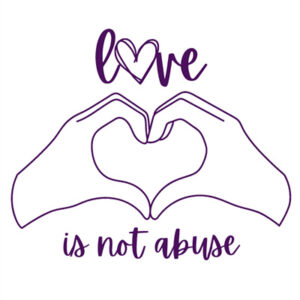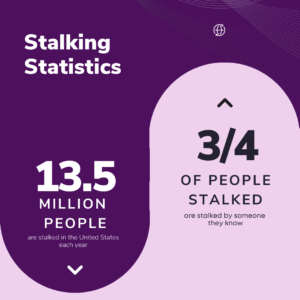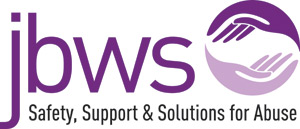
Before reading, please be aware that this page contains information about domestic violence and intimate partner abuse that may be triggering to some people. If you are in an unhealthy relationship and need support, please call our 24-Hour Helpline at 1.877.782.2873

What is domestic violence?
Domestic violence is a pattern of behaviors used to maintain power and control over another person. It can happen to anyone without regard to age, gender, sexual orientation, race, or socio-economic status. Abuse can occur in any heterosexual, homosexual, or queer relationships. However, the relationship does not need to be romantic to experience domestic violence. Elder abuse, sibling abuse, and child abuse all fall into this category as well.

Intimate Partner Violence vs. Domestic Violence
Some people use domestic violence and intimate partner violence interchangeably. However, they are distinctly different terms. Domestic violence refers to all abuse that happens within the home.
Intimate partner violence is a form of domestic violence and refers to intimidation, control, and abuse that can occur within a romantic or sexual relationship.

How common is it?
Since 1 in 4 women, 1 in 7 men, and 1 in 3 teenagers have experienced domestic violence, it is very likely that someone you know is currently experiencing it.
However, just because it’s common, does not mean that it is normal. No one should make you feel unsafe in your relationship.

Does the length of the relationship matter?
You do not need to be married to your partner or in a long-term committed relationship to experience domestic violence or dating abuse.
You can experience abuse whether you met your partner three weeks ago or have lived with them for numerous years.
How Can Domestic Violence Show Up in a Relationship?
There is a common misconception that domestic violence is only physical. However, that is not true. There are numerous types of abuse that do not include anything physical. If you are concerned about your relationship and need support, JBWS is always here.
24-Hour Helpline & Referral: 1.877.R.U.ABUSED, or 1.877.782.2873
Deaf/Hard of Hearing: Text 973.314.4192
Hablamos Español Interpreters Available
The content below may be triggering. If you are in need of coping skills or grounding techniques, please click here.
This type of abuse refers to nonphysical behaviors intended to exploit another person’s vulnerabilities, insecurities, or character. For instance, constantly criticizing you, making you feel guilty, manipulating you, or trying to control you.
Signs of emotional abuse:
- Insulting, criticizing, or undermining your self-confidence:
- This could include “jokes” that make you feel worthless, having a hypercritical opinion on everything you’re doing, making fun of your hopes, dismissing your dreams, and actual or threatened rejection
- Doing things to make you feel like you’re losing your mind:
- This could include saying one thing but doing another, stating untrue facts as the truth, neglecting to follow through on stated intentions, or intentionally doing things to make you feel “crazy.” For instance, hiding your car keys and then berating you for losing them
- Neglecting your needs or request:
- This refers to when your partner consistently disregards, ignores, or neglects your needs and requests. For instance, they often dismiss your feelings, call you “too sensitive,” and claim you’re being “crazy”
- Embarrassing or humiliating you:
- When your partner intentionally humiliates you by using actions, statements, or gestures to attack your self-esteem and self-worth publicly or privately
- Using guilt to manipulate or control you:
- An abusive partner may guilt trip you in an attempt to control your actions and behaviors. For instance, they make you feel terrible for seeing your friends because you’re leaving them alone
If you are concerned about your relationship and need support, help is available. Please call JBWS’ 24-Hour Helpline at 1.877.782.2873. Exit to grounding and coping skills here.
Financial abuse occurs in 99% of all abusive relationships. Designed to impact your ability to access money, make money, or maintain financial stability, this form of abuse is often why people don’t feel comfortable leaving their abusive relationships. In fact, according to National Network to End Domestic Violence, “surveys of survivors reflect that concerns over their ability to provide financially for themselves and their children was one of the top reasons for staying in and returning to an abusive partner.”
However, financial abuse may be difficult to spot at first. It may even appear that your partner is being attentive and supportive of your needs. They may say, “You have so much going on right now, why don’t you let me worry about the finances and I’ll give you money each week to take care of your needs.” This may lead to your partner giving you a strict allowance, moving your money, or denying you access to family funds. In other situations, the financial abuse might be more overt, and your partner may forbid you from working or openly deny your access to family funds.
Signs of financial abuse:
- Compromising your ability to work:
- Not allowing you to work, harassing you at your workplace, sabotaging your employment opportunities, causing you to lose your job by physically assaulting you prior to important meetings or interviews, or forcing you to work at their family business without pay
- Sabotaging your career advancement opportunities:
- Not supporting potential professional training or advancement opportunities that would advance your career or provide financial freedom
- Controlling all the financial decisions:
- Controlling how all the money is spent, not consulting you in investment or banking decisions, not giving you access to your bank accounts, giving you an “allowance,” or hiding your monetary assets, refusing to contribute to the family income, forcing you to turn over financial benefits to them
- Ruining your financial stability:
- Forcing you to write bad checks or file fraudulent tax returns, running up large amounts of debt on your joint accounts, refusing to pay your bills and ruining your credit score, filing false insurance claims, or stealing your identity, property, or inheritance
- Withholding funds that support basic needs:
- Another method of financial control is withholding basic needs such as refusing to pay child support, manipulating the divorce process by intentionally drawing it out by hiding or not disclosing assets, or refusing to pay for basic needs such as food and medicine
Without monetary assets, survivors can struggle to find affordable housing and may have difficulty acquiring the funds necessary to provide for themselves and their children. With ruined credit scores, inconsistent employment history, and legal issues caused by abuse, it’s difficult to leave an abusive partner.
However, help is available. JBWS offers both short and long-term residential services to people leaving their abusive partners. Our Transitional Living Program can house survivors for up two years in one of our 11 fully furnished apartments. While in this program, survivors have access to financial literacy training, professional development, and other career related services intended to combat financial abuse.
If you are concerned about your relationship and need support, help is available. Please call JBWS’ 24-Hour Helpline at 1.877.782.2873. Exit to grounding and coping skills here.
Regardless of whether or not your partner has been physically abusive in the past or uses physical abuse as a method of control, intimidation tactics suggest that there is a potential for violence. Intimidating another person can often provide the abusive partner with the control that they are seeking because it’s intended to make you feel at risk if you don’t.
Signs of intimidation:
- Making someone feel afraid:
- This could be done with just a look, action or gesture designed to make you feel at risk or intimidated in some way. This could be done by abusing pets, displaying weapons, or other behaviors that make you feel scared
- Physically aggressive behavior not directed at you:
- Throwing a remote across the room, punching a wall during an argument, smashing something in frustration, destroying property are all forms of intimidation
If you are concerned about your relationship and need support, help is available. Please call JBWS’ 24-Hour Helpline at 1.877.782.2873. Exit to grounding and coping skills here.
Closely connected to controlling behaviors, isolation is the outcome of multiple forms of abusive behaviors. As the name suggests, isolation refers to any behavior that removes you from your support group, interests, and goals. To prevent you from leaving the relationship, your partner may keep you from seeing who you want, doing what you want, and controlling your thoughts. This makes accessing both personal and public resources more difficult. Additionally, preventing you from seeing friends, family, or acquaintances ensures that you aren’t around people who may challenge the perceptions or beliefs that your abusive partner uses to maintain control.
Like with other forms of abuse, isolation often appears as an expression of love for you. For instance, “I love you so much and if you loved me the same, you’d choose to spend time with me instead of your friends.” As the isolation progresses, your abusive partner may limit or prevent you from contacting anyone else.
Signs of Isolation:
- Using jealousy to justify actions:
- “You know I’ve been cheated on in the past, that’s why I’m not comfortable with you making new friends,” or “I’m insecure about my body and can’t stop thinking about you leaving me when you talk to other people.”
- Controlling your social groups:
- Your partner may attempt to prevent you from seeing or talking to friends of yours or actively try and turn you against your friends by pointing out all of their perceived flaws
- Controlling your actions:
- Your partner may try and control where you go, what you read, or limit your outside involvement in clubs, sports, hobbies. They may also go through your phone, listen in on your conversations, or open mail.
It’s important to note that a person experiencing abuse may also isolate themselves from existing resources due to shame. They may be concerned about their abusive partner’s behavior in public, their treatment of their loved ones, or develop a fear of public humiliation.
If you are concerned about your relationship and need support, help is available. Please call JBWS’ 24-Hour Helpline at 1.877.782.2873. Exit to grounding and coping skills here.
Since individuals experiencing domestic violence are three times more likely to report symptoms of severe depression, mental health coercion may be a powerful method of control. According to the Delaware Coalition Against Domestic Violence, 50% of individuals experiencing domestic violence say that their partner threatened to report their mental health to limit things they wanted or needed. Additionally, 90% of women hospitalized post-suicide attempt reported currently experiencing severe domestic violence.
Signs of Mental Health Coercion:
- Controlling your medications:
- Withholding your medicine or coercing you to take medicine
- Undermining your sanity:
- Constantly diagnosing you, telling your friends and family that you are unstable
- Threatening to report mental health issues:
- Threatening to report these struggles to influence custody hearings, manipulate police, or influence other matters
- Using Stigma around mental health:
- Using this stigma to make you believe that no one will believe you about your partner's behavior
Regardless of your mental health struggles, you have the same right to safety and dignity as anyone else. It does not matter what mental health condition you have, whether or not you have been hospitalized, or if you’re on medication, you have the same right to kindness and compassion.
If you are concerned about your relationship and need support, help is available. Please call JBWS’ 24-Hour Helpline at 1.877.782.2873. Exit to grounding and coping skills here.
A person using abuse may minimize or deny their abusive behavior to make you second guess yourself. These behaviors can make you question your own judgement and wonder whether or not you overreacted to a situation. Additionally, when a person blames you for their abusive behavior, it can reinforce the notion that changing your behavior will stop the abuse. Memories of the relationship before the abuse began can make you believe that it is possible to “go back” to the way things were before if you could just “stop doing” certain behaviors.
Signs of minimizing, denying, and blaming:
- Making light of the abusive behavior
- Not taking your concerns seriously
- Claiming the abuse did not happen
- Insisting that you are making up the abuse
For example: You go to a club for a friend’s birthday and your partner reacts by calling you incessantly or showing up at the club. When you react negatively to this behavior, your partner might say: “I’ve never felt this way about someone before, I get so jealous thinking about you in the club with other people dancing all over you.” In order to prevent another situation like this, you may decide that the easiest solution is to avoid the club. Unfortunately, this won’t prevent abuse from occurring in the future. It establishes a pattern of you changing your behavior to accommodate the controlling desires of your partner.
If you are concerned about your relationship and need support, help is available. Please call JBWS’ 24-Hour Helpline at 1.877.782.2873. Exit to grounding and coping skills here.
Physical abuse refers to any physically aggressive behavior. This could be acts of physical violence, the withholding of physical needs, the threat of physical abuse, or indirect physically harmful behavior.
Examples of physical violence:
- Hitting, kicking, biting, slapping, shaking, pushing, pulling, punching, choking, berating, scratching, pinching, pulling hair, stabbing, shooting, drowning, burning, threatening with a weapon, hitting with an object, or threatening to physically assault you.
Examples of withholding physical needs:
- Interrupting your sleep or disturbing your meals
- Denying money, food, transportation, or help if sick or injured
- Locking someone into or out of the house
- Refusing to give or rationing necessities
Examples of threatening physical abuse:
- Abusing, injuring, or threatening to injure children, pets, or special property
- Forcible physical restraint against the other person’s will
- Being trapped in a room or having the exit blocked
- Being held down
Examples of indirect physically harmful behavior:
- Hitting or kicking walls, doors, or other inanimate objects during an argument
- Throwing things in anger
- Destroying property
There are some forms of physical abuse that can be early warning signs of escalation that some may not identify as physical abuse, such as a wrist grab, push, or shove. In some relationships, there can be an escalation to physical abuse when a relationship changes. For instance, when you move in together, get married, become pregnant, or when the person behind abused tries to leave. Just because the relationship is not physically abuse right now, does not mean it will remain that way.
If you are concerned about your relationship and need support, help is available. Please call JBWS’ 24-Hour Helpline at 1.877.782.2873. Exit to grounding and coping skills here.
When a person takes your ability to control your own reproductive system, that is known as reproductive coercion. This can be difficult to identify because it’s a less visible form of abuse. It can appear as pressure, guilt, or shame about you having, wanting to have, or not wanting to have children.
Signs of reproductive coercion:
- Forcing you to get an abortion
- Forcing you to get In vitro fertilization treatments
- Pressuring you into becoming pregnant
- Sabotaging your birth control
- Controlling your access to reproductive healthcare or education
- Being forced into
If you are concerned about your relationship and need support, help is available. Please call JBWS’ 24-Hour Helpline at 1.877.782.2873. Exit to grounding and coping skills here.
Sexual assault is used to describe a number of sexual crimes including rape, unwanted touching, sexual harassment, public indecency, demeaning a person’s body, taking photos or videos without consent, withholding sex, threatening to have an affair if the partner doesn’t provide sex, and more. While most sexual assaults are perpetrated by someone known to the victim, sexual abuse and assault within an abusive relationship adds another layer to this dynamic.
To discuss sexual abuse, it’s important to understand consent. Consent is an active choice and is only possible when there is equal power. Consent is not giving in because of fear, going along with something because of feeling badly, or being deceived into it. Sometimes you may not feel safe saying no. It’s important to remember that consenting to sexual activity in the past does not indicate current consent.
Signs of Sexual Abuse:
- Your partner has forced you to do things sexually that you were uncomfortable with
- Your partner has pressured you into having sex
- Your partner has had sex with you while you were sleeping or severely intoxicated/high
- Your partner forced you to perform sexual acts against your will
- You were afraid to say no to your partner when sex was requested
If you are concerned about your relationship and need support, help is available. Please call JBWS’ 24-Hour Helpline at 1.877.782.2873. Exit to grounding and coping skills here.
Spiritual abuse can happen in any form of religion or denomination. However, the power rests in how much you value these spiritual beliefs. For people who have a strong faith, an abusive partner might use spiritual abuse to manipulate or control your behaviors.
Signs of Spiritual Abuse:
- Isolating you from your church or faith community
- Using scripture or religious beliefs to justify their abuse
- Degrading or belittling you for your religious beliefs
- Using their status in the faith community to intimidate you
Note: A faith leader or community, and their response to the problem of domestic violence, can also have a major impact on a person's ability to recognize their experience as abuse and/or get free from it.
If you are concerned about your relationship and need support, help is available. Please call JBWS’ 24-Hour Helpline at 1.877.782.2873. Exit to grounding and coping skills here.

What is Stalking?
Stalking is the willful, malicious, and repeated following or harassing of another person which is accompanied by a credible threat of violence.
When a person using abuse engages in stalking during a relationship or after it has ended, this is considered a high-risk behavior.
Stalking Includes:
- Mailing you cards or cryptic messages
- Breaking windows or vandalizing your home
- Destroying your property to scare or intimidate you
- Leaving things, such as flowers, on your doorstep or at work
- Watching you from a distance, hiding in bushes, or other methods of surveillance
- Filing for custody of children regardless of their needs
- Not respecting visitation limitations, harassing telephone calls, violating restraining orders
If you are concerned about your relationship and need support, help is available. Please call JBWS’ 24-Hour Helpline at 1.877.782.2873. Exit to grounding and coping skills here.
When a person uses their privilege or societal status to threaten you or treat you as less than, that is known as status abuse. This can refer to any type of status including: immigration status, cisgender privilege, white privilege, male privilege, or status within the community as a political leader, law enforcement officer, celebrity, faith leader, or more.
Signs of Status Abuse:
- Treating you like a servant
- Excluding you from the decision-making process
- Acting like a dictator
If you are concerned about your relationship and need support, help is available. Please call JBWS’ 24-Hour Helpline at 1.877.782.2873. Exit to grounding and coping skills here.
As part of a broader pattern of abuse and control, substance abuse coercion refers to the active use of substance abuse issues against a partner. According to the Delaware Coalition Against Domestic Violence, 47%-90% of women in substance use disorder treatment have experienced domestic violence in their lifetime, 60% of participants in the Substance Abuse Coercion Study report their partners had tried to interfere with their treatment, and 90% of women attending a methadone clinic had experienced domestic violence.
Signs of Substance Abuse Coercion:
- Introducing you to substances and forcing you to use them more than you want
- Forcing you into withdrawal or using addition to control
- Coercing you to engage in illegal acts
- Deliberately sabotaging your recovery efforts or access to treatment
- Using the stigma around substance abuse to make you think no one will believe you about the abuse you’re experiencing
Please note, it is never your fault when someone harms you if you are drinking or using. You deserve to be treated with dignity and respect.
If you are concerned about your relationship and need support, help is available. Please call JBWS’ 24-Hour Helpline at 1.877.782.2873. Exit to grounding and coping skills here.
Technology abuse refers to the use of the internet or other electronic means to stalk or harass an individual, group, or organization. This could include false accusations, defamation, monitoring, slander and libel, or gathering information to threaten, embarrass, or harass. Technology abuse usually happens in five main categories: disrupting, impersonating, harassing, monitoring/stalking, and revenge porn.
Types of Technology Abuse:
- Disrupting:
- This includes things like hacking into your online account and locking you out, forbidding you from using you technological devices, or breaking those devices.
- Impersonating:
- When a person creates accounts presenting to be you to harass you, your friends, and family.
- Harassing:
- This is defined as sending messages repeatedly through texts, email, or other messaging applications
- Monitoring/Stalking:
- One of the most common forms of technology abuse, monitoring/stalking can be done through computer/cell phone software, hidden cameras, GPS, picture tagging, family phone plans, or fitness trackers.
- Revenge porn:
- This refers to distributing sexual photos or videos without your consent. Regardless of whether you consented to be in the photos or videos, distribution is illegal and threats to distribute these can trap you in a relationship.
If you are concerned about your relationship and need support, help is available. Please call JBWS’ 24-Hour Helpline at 1.877.782.2873. Exit to grounding and coping skills here.
Even if you’re not sure whether or not the threat could be carried out, the potential of the threat is enough to control another person.
Threats and Coercion can include:
- Making or carrying out threats to hurt someone or their family
- Threatening to make a report to welfare
- Threatening to take custody of the children
- Threatening to leave or commit suicide
The threat of suicide should always be taken seriously. The majority of murder/suicides in the US are connected to domestic violence, so a threat of suicide could also indicate that the life of the person being abused and/or their children may also be in danger.
Coercion is the use of manipulation to control your thoughts, actions, and behaviors. This can include making you drop charges or do illegal things. However, it can refer to a more nuance dynamic called coercive control. This is a form of psychological abuse where the person being abusive carriers out a pattern or controlling and manipulative behaviors to establish power over you.
If you are concerned about your relationship and need support, help is available. Please call JBWS’ 24-Hour Helpline at 1.877.782.2873. Exit to grounding and coping skills here.
